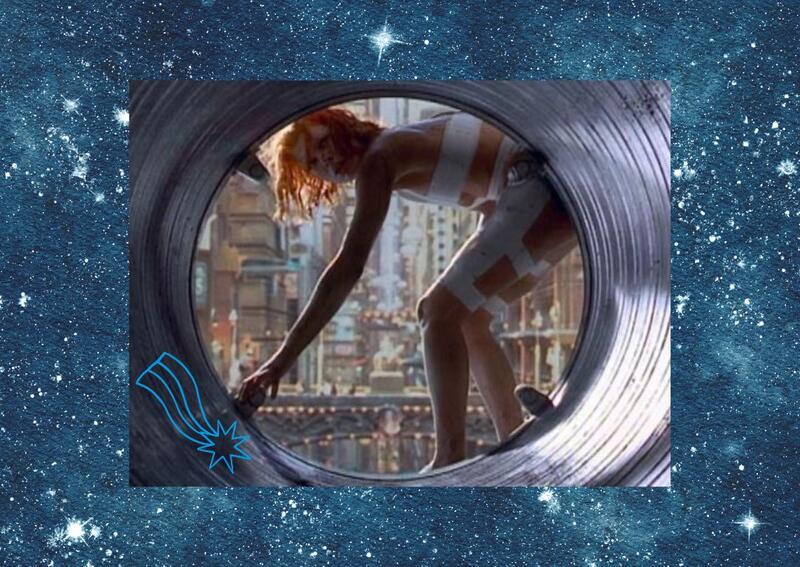Finding Tzniut in The Fifth Element's Futurist Costumes
It was a family movie night and we were watching one of my mom’s favorite movies, The Fifth Element (1997). While I usually struggle to enjoy older sci-fi movies since the special effects look off to me, I loved The Fifth Element. The sets, clothing, and actors meant that it felt of the sci-fi genre without looking like it was made with technology that, with our current CGI, seems ancient. However, as I reflect back on the movie, I see more than flashes of color creating a futuristic universe. Instead, I focus on the positive message the designer sends through the outfits of one of the main characters, Leeloo.
The Fifth Element takes place in the 23rd century when a Great Evil, depicted as a sentient asteroid-like being, appears, whose purpose is to destroy all life on Earth. The Mondoshawan, an alien race, attempts to bring back to earth The Fifth Element that can, in conjunction with four stones (representing the elements), save the planet from the Great Evil. An evil alien race destroys the Fifth Element on its journey to Earth. However, a team of scientists use the DNA of the remains to rebuild it into a perfect being, called Leeloo (Milla Jovovich). When Leeloo wakes up she is scared by the new environment and jumps out of the lab building. She lands in the flying cab of Korben Dallas (Bruce Willis), an ex-military New York taxi driver. He is then asked by the military to help Leeloo get the four stones, come back to Earth, and save the world.
This dystopian world was created through use of sets and costumes. The costume designer for the movie was French fashion designer Jean-Paul Gaultier. He was known for drawing inspiration from bondage, punk rock, lingerie and streetwear. When Luc Besson, the director, approached him about designing the costumes for The Fifth Element, Gaultier jumped on it. His clothing broke gender roles and played on the idea of showing skin. This can be seen in the opening outfit for Leeloo. She is wearing a thin bandage-like material which barely covers her nipples and crotch and is held onto her body across her hips and shoulders like a harness. While many actresses feel forced into revealing costumes, it was actually Jovovich’s idea to use bandages. When Besson shared her idea with Gautlier, the designer was ecstatic since it linked to his aesthetic and interests.
Leeloo’s character is not ashamed of being exposed in this outfit, yet when given the option to change she is quick to do so-- not because she wants to cover up but because the bandages are not functional for her to move in. What makes this costume change iconic is that Leeloo begins taking off the bandages with an audience of two men. This is not sexualized or done to try and bring attention to her body, but rather to show that she sees her body just as a body. Through the direction of this scene and Leeloo’s costume, Besson and Gautlier create an aspirational society in which a woman does not feel exposed or sexualized because of what she wears.
This aspirational world is in direct contrast to the reality of many girls attending Orthodox schools, who, in the past decade, have been writing articles about how they feel sexualized through the attention put on the way they cover their body by the enforcement of a modest dress code. The goal of Orthodox clothing is the idea of Tzniut, which is usually translated as modesty, but has a deeper meaning along the lines of dignity and humility through modesty. Typically, knees, elbows, ankles, and chest are covered with loose skirts below the knees, three-quarter sleeves, high necklines, and leggings or knee high socks. Sharon Weiss-Greenberg recounts an incident when she and a friend were called out for exposing their ankles (wearing short socks) by the principal of her Orthodox school in Minnesota. As each girl walked by, the principal stared at their legs to check that they had their ankles covered. She writes that after he first noticed, “he didn’t say a word; he repeatedly looked our bodies up and down with a smug look on his face.” Her friend told her that she was later taken to his office and told that wearing short socks was the equivalent of premarital sex. A similar incident happened to Melissa Ducha, who went to an Orthodox school in New York where two women stood at the entrance of the school and checked whether the girls’ skirts were long and loose enough. In both instances, the girls felt sexualized. Instead of the dress code enabling tzniut and allowing them to feel that their clothing choices invoked a feeling of self-dignity and humility, the focus was placed on a modesty judged by the amount of skin showing.
In The Fifth Element, Leeloo is just as comfortable and empowered in the revealing bandages and in her streetwear costume. Her clothes don’t define her morality, dignity, humility, or modesty. Perhaps equally important, she does not feel judged because nobody is telling her that her clothing choices are sexual statements. When reflecting on the film, the message I want to take is to “be Leeloo,” for each woman to be empowered and comfortable with her choices without regard to other’s view or judgment. And, for us, as a society, to evolve to one that promotes, accepts and encourages individual expression without exception.
This piece was written as part of JWA’s Rising Voices Fellowship.







